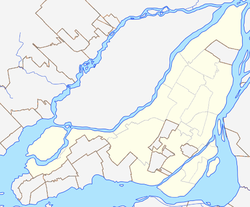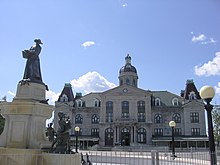Hochelaga-Maisonneuve
Hochelaga-Maisonneuve | |
|---|---|
 Row houses on typical side street | |
 | |
| Nickname(s): HOMA | |
 Hochelaga-Maisonneuve Location of Hochelaga-Maisonneuve in Montreal | |
| Coordinates: 45°33′11″N 73°32′31″W / 45.553°N 73.542°WCoordinates: 45°33′11″N 73°32′31″W / 45.553°N 73.542°W | |
| Country | Canada |
| Province | Quebec |
| City | Montreal |
| Borough | Mercier–Hochelaga-Maisonneuve |
| Postal code(s) | |
| Area code(s) | 514 and 438 |
| Website | https://hochelaga.ca |
Hochelaga-Maisonneuve (French pronunciation: [ɔʃlaɡa mɛzɔ̃nœv]) is a neighbourhood in Montreal, Canada, situated in the east end of the island, generally to the south of the city's Olympic Stadium and east of downtown.
Historically a poor neighbourhood, it has experienced significant change and gentrification in recent years.[1]
History[]
Early history[]
Hochelaga was named after the Iroquois village of the same name, first visited by explorer Jacques Cartier in 1534. The neighbourhood was at one time believed to be the location of the historic village, but modern historians and anthropologists have not reached agreement on the exact location.[2]

Present-day Hochelaga was founded as a rural village in 1870. Industry soon started moving in, including the Hudon and Sainte-Ann cotton mills and in 1876 the terminal and railway shops of the Quebec, Montreal, Ottawa and Occidental Railway.[3]
In December 1883, Hochelaga was annexed to the city of Montreal against the demands of landowners. In response, they founded the village of Maisonneuve to the east, intended to be a model industrial city.
Maisonneuve grew rapidly between 1896 and 1915 and became of one Canada's largest industrial slums, commonly known as the Pittsburgh of Canada throughout the early 20th century.
These factories hired many workers, including immigrants and people from the surrounding countryside. They worked in the shoe, textile, tanning, slaughterhouse, tobacco, food, and shipbuilding industries.
In 1918, $18 million in debt, Maisonneuve was forced to annex to Montreal, consolidated the neighbourhood as Hochelaga-Maisonneuve.[3]
The botanical garden was opened in 1931.
Decline[]
The construction of major transportation infrastructures such as Highway 25 in 1967, required the demolition of some 2,000 homes and institutional buildings. These changes, combined with the movement of capital and production to Toronto, hurt the neighbourhood's economy and vitality. Many factories left the area, along with numerous residents.
In 1976 the Olympic Stadium was opened, in time for the Summer Olympics.
Beginning in the 1980s, factories started shutting down at an alarming rate, leaving the neighborhood ridden with poverty and a high concentration of welfare, especially in Hochelaga. This has led to a population exodus, high crime rates and a general negative portrait of the area.[4]
It became particularly notorious for prostitution, which has been problematic for many years.[5][6][7][8][9]
During the Quebec Biker War, the Hells Angels had their clubhouse in Hochelaga-Maisonneuve, which worsened its reputation for criminality.
In the most notorious incident of the guerre des motards, on 9 August 1995, a drug dealer was killed by a bomb planted in his jeep while the shrapnel badly injured an 11-year boy, Daniel Desrochers, who died of his wounds four days later.[10][11]
Present day[]
The 2010s were marked by increased gentrification, the arrival of students and professionals, and condo development leading to protests and some cases of vandalism of commerce.[1][12] Notable areas that developed include the Promenade Ontario shopping street[13] and the recently revitalized Place Simon Valois.[14]
Despite this, areas continue to struggle with poverty, prostitution and drug trafficking, particularly in the south-western corner of Hochelaga on Rue Sainte-Catherine Est.[9][8]
In summer 2020, in the same area, a significant number[clarification needed] of homeless people began camping along Rue Notre-Dame, creating something akin to a tent city. This was attributed in part to the ongoing housing crisis in Montreal, as well as overcrowding of existing shelters.[15]
In December 2020, the camp was shut down by the police, following a fire a few days earlier and hygiene concerns. This occurred despite promises from the mayor that they would not be forcibly relocated.[16]
Features[]
A notable attraction is the Olympic Park, which contains the Stadium, Olympic Tower, Saputo Stadium, Biodome, Olympic Pool and Maurice Richard Arena.
Part of Parc Maisonneuve is in the neighbourhood, as it the Marché Maisonneuve, one of the city's largest public markets.
Recent features to develop include Promenade Ontario, a shopping street that becomes pedestrian in the summer to host street fairs and street performers.[13]
The revitalized Place Simon Valois, a public square on the corner of Ontario and Valois, is home to a variety of new commerces and attractions as well.[14][17]
The borough operates the Hochelaga and Maisonneuve libraries respectively.[18][19]

Geography[]
A part of the borough of Mercier–Hochelaga-Maisonneuve, its borders are roughly the CP rail line west of Rue Moreau to the west, Rue Sherbrooke to the north, the train tracks east of Rue Viau to the east, and the Saint Lawrence River to the south.
Boulevard Pie-IX is the traditional dividing point between Hochelaga and Maisonneuve.
It is bordered by Ville-Marie (Centre-Sud) to the west, Rosemont–La Petite-Patrie to the north, and Mercier to the east.
Its main commercial arteries running east to west are Rue Sainte-Catherine Est, Rue Ontario, Rue Hochelaga and Avenue Pierre de Coubertin.

Transportation[]
Hochelaga-Maisonneuve is served by the Préfontaine, Joliette, Pie-IX and Viau stations on the Green Line.
The following STM bus routes transit through the neighbourhood;
| showSociété de transport de Montréal | |||
|---|---|---|---|
| No. & Route Name | |||
Popular culture[]
Hochelaga-Maisonneuve is prominently featured in Québécois culture and media.
Notable songs about the neighbourhood include Voyou by Les Cowboys Fringants,[20] Hochelaga by Alexandre Poulin[21] as well as La Question a 100 Piasses[22] and Rue Ontario[23] by Bernard Adamus.
The film Hochelaga directed by Michel Jetté and the documentary East End Forever are also about the neighbourhood.
Politics[]
Hochelaga-Maisonneuve is located in the federal riding of Hochelaga, and represented by MP Soraya Martinez Ferrada of the Liberal Party.
Provincially it's located in the riding of the same name, and represented by MNA Alexandre Leduc of Québec Solidaire.
Municipally it's part of Hochelaga and Maisonneuve–Longue-Pointe, represented by Éric Alan Caldwell and Laurence Lavigne-Lalonde of Projet Montréal at the Montreal City Council.
Notable people[]
- Pierre Falardeau, film director, activist for Quebec independence[24]
- Julien Poulin, film director and actor[25]
- Bernard Adamus, singer-songwriter[26]
- Robert Guy Scully, journalist, English-rights activist
- Maurice Boucher, outlaw biker, former Hells Angels president[27]
Education[]
The Commission scolaire de Montréal (CSDM) operates French-language public schools.[28]
Elementary[]
- École Baril
- École Notre-Dame-de-L'Assomption
- École Maisonneuve
- École Saint-Clément
- École Saint-Jean-Baptiste-de-Lasalle
High School[]
- École Sécondaire Chomedey-De Maisonneuve
Specialized[]
- École des Métiers de la Construction de Montréal
- École pour Adultes Centre Hochelaga-Maisonneuve
- École Eulalie-Durocher (for intellectually disabled)
The English Montreal School Board (EMSB) operates English-language schools.[29]
Elementary[]
- Edward Murphy Elementary School (in nearby Mercier)
High School[]
(for high school, students must go to nearby Vincent Massey Collegiate in Rosemont)
See also[]
- Centre-Sud, nearby neighbourhood with similar background and history
- Hochelaga, federal electoral district
- Hochelaga-Maisonneuve, provincial electoral district
References[]
- ^ Jump up to: a b "Hochelaga-Maisonneuve residents rally against gentrification". Montreal: Global News. 20 May 2018. Retrieved 26 November 2020.
- ^ Bruce G. Trigger, "The Disappearance of the St. Lawrence Iroquoians", in The Children of Aataenstic: A History of the Huron People to 1660, vol. 2], Montreal and London: Mcgill-Queen's University Press, 1976, pp. 214-218, accessed 2 Feb 2010
- ^ Jump up to: a b http://www.memorablemontreal.com/accessibleQA/en/histoire.php?quartier=7
- ^ Portrait du Territoire, L'Arrondissement Mercier/Hochelaga-Maisonneuve. Centreaide du Grand Montréal, Service d'analyse et d'allocation sociale. Octobre 2003
- ^ "Police issue warnings to Hochelaga-Maisonneuve sex workers". Montreal: CTV News. 17 July 2010. Retrieved 9 February 2021.
- ^ Caron, Steve (14 June 2012). "Prostitution : une zone de tolérance dans Hochelaga-Maisonneuve?" (in French). Montreal: Journal Métro. Retrieved 4 December 2020.
- ^ Sauves, Ewan (21 October 2012). "Hochelaga-Maisonneuve: des appartements pour les prostituées dès 2013" (in French). Montreal: La Presse. Retrieved 4 December 2020.
- ^ Jump up to: a b Forget, Dominique (8 May 2013). "Mon quartier me rend malade" (in French). Montreal: L'Actualité. Retrieved 22 November 2020.
- ^ Jump up to: a b "Une piquerie d'Hochelaga exaspère les voisins" (in French). Montreal: Journal de Montréal. 24 July 2020. Retrieved 26 November 2020.
- ^ "Un décès qui a marqué un tournant dans notre histoire" (in French). Montreal: Journal de Montréal. 9 August 2020. Retrieved 26 November 2020.
- ^ "Quebec biker war's innocent victims: 'I never thought it would happen to my son'". Montreal: Montreal Gazette. 13 July 2019. Retrieved 26 November 2020.
- ^ "État des lieux de la gentrification dans Hochelaga-Maisonneuve" (in French). Montreal: Le Devoir. 5 May 2017. Retrieved 26 November 2020.
- ^ Jump up to: a b "La rue Ontario sera piétonne cet été". Montreal: Journal Métro. 22 June 2020. Retrieved 10 December 2020.
- ^ Jump up to: a b "La piétonnisation de la place Simon-Valois décalée en 2018". Montreal: Journal Métro. 29 May 2017. Retrieved 7 February 2021.
- ^ "'We feel bad enough that we live like this': Montreal's tent city expands into dozens". Montreal: CTV News. 14 August 2020. Retrieved 21 December 2020.
- ^ "Police, fire department begin shutdown of Montreal's tent city for homeless". Montreal: CTV News. 6 December 2020. Retrieved 21 December 2020.
- ^ "Le droit au quartier". Montreal: Actualités UQAM. 11 December 2018. Retrieved 10 December 2020.
- ^ https://montreal.ca/lieux/bibliotheque-hochelaga
- ^ https://montreal.ca/lieux/bibliotheque-maisonneuve
- ^ https://www.youtube.com/watch?v=8Ql1LkBCpfk Voyou by Les Cowboys Fringants (2001)
- ^ https://www.youtube.com/watch?v=jSH6_Qhz3bcand Hochelaga by Alexandre Poulin (2013)
- ^ https://www.youtube.com/watch?v=QsIRzOwzrmg La Question a 100 Piasses by Bernard Adamus (2010)
- ^ https://www.youtube.com/watch?v=AmhskszxZF4 Rue Ontario by Bernard Adamus (2010)
- ^ https://www.youtube.com/watch?v=-nS01aQ79M8 0:30
- ^ https://www.journaldemontreal.com/2012/01/21/-ca-a-clique-naturellement-
- ^ https://exclaim.ca/music/article/bernard_adamus
- ^ https://www.ledevoir.com/societe/90097/maurice-boucher-de-petit-delinquant-a-taulard “Il est âgé de deux ans lorsque la famille quitte la Gaspésie pour Hochelaga-Maisonneuve, le quartier sur lequel il voudra régner en roi et maître lorsqu'il deviendra membre en règle des Hells Angels”
- ^ https://www.cssdm.gouv.qc.ca/trouver-une-ecole/
- ^ https://www.emsb.qc.ca/emsb/schools/elementary/school-search
External links[]
| Wikisource has the text of the 1921 Collier's Encyclopedia article Maisonneuve. |
 Hochelaga-Maisonneuve travel guide from Wikivoyage
Hochelaga-Maisonneuve travel guide from Wikivoyage
- Neighbourhoods in Montreal
- History of Montreal
- Mercier–Hochelaga-Maisonneuve
- Red-light districts in Canada
- Urban decay in Canada
- Poverty in Canada
- Gentrification in Canada
- Hipster neighborhoods

